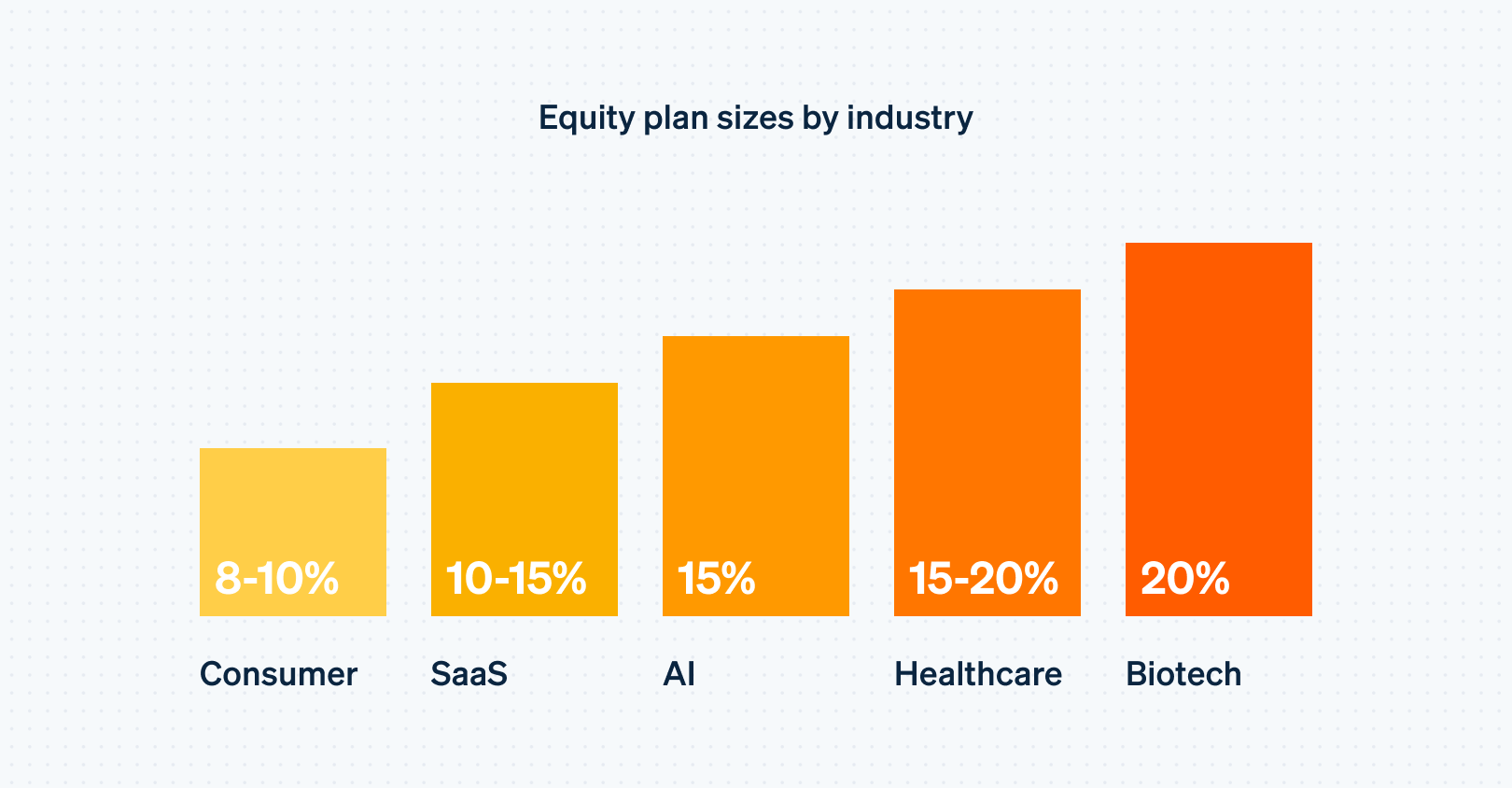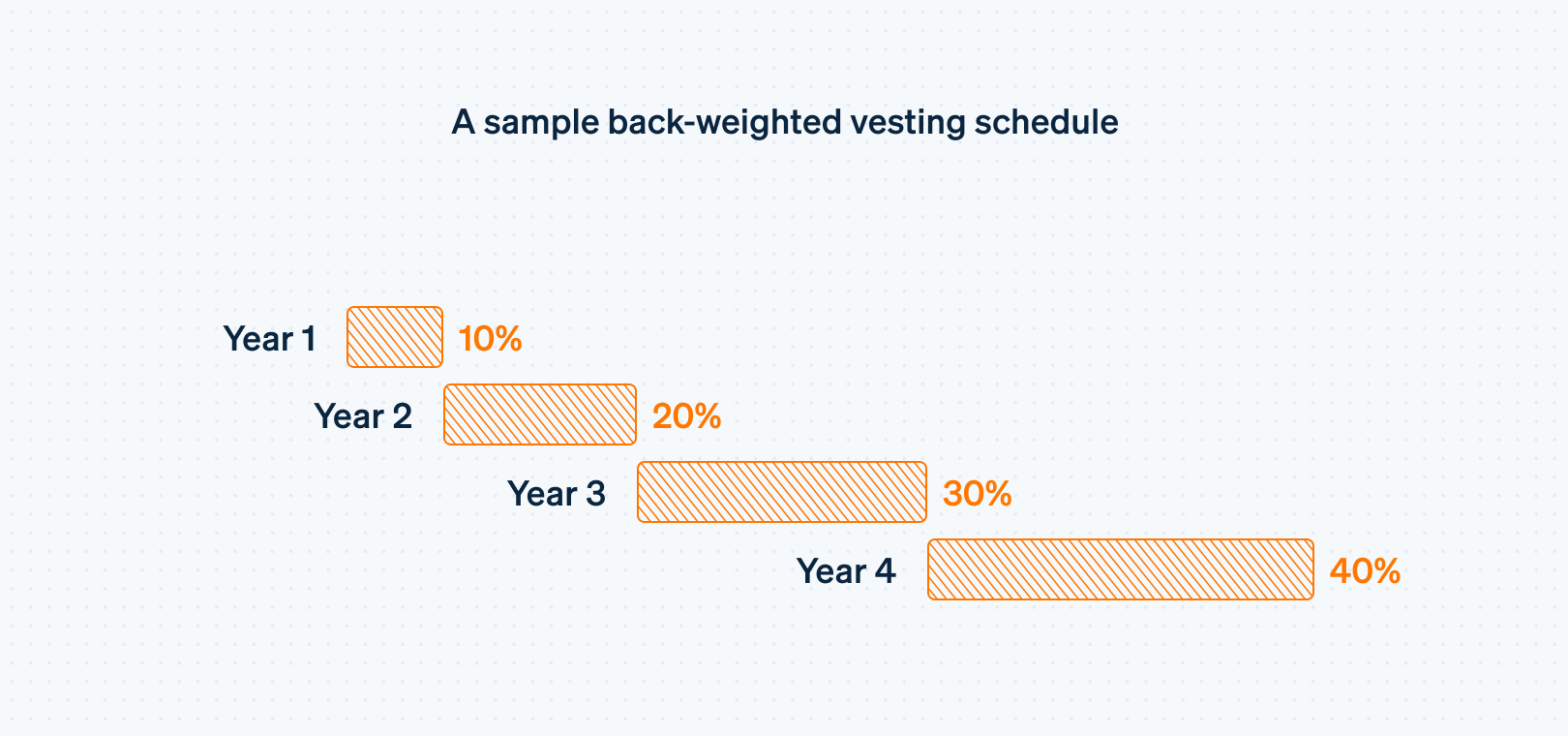股权是公司的所有权单位。它有两个特点:经济利益和控制权。经济利益是指商家业绩良好时获得的经济收益。控制权是股权所有者对公司未来的影响力。
一般来说,公司会向三类利益相关者授予股权:创始人、员工和投资者。Stripe Atlas 曾编写过一份创始人股权指南;而本文将重点介绍员工股权。
本指南与初创公司创始人最为相关。股权是一种强有力的工具,既能回报早期员工承担风险加入团队(招聘),又能持续激励他们留在公司(留任)。招聘与留任是员工股权的两大目标,在决定员工股权事宜时,应始终将其置于首要考虑位置。
看完本指南,您会了解:
股权计划的定义及如何确定其规模
如何在股权计划中处理员工离职或解雇事宜
股权兑现的三大目标以及如何制定股权计划来实现这些目标
授予股权的方式及其优缺点
ISO 与 NSO 的区别以及应避免的常见错误
Pulley 在帮助了数千家公司管理股权结构表和股权的基础上提出的建议
Pulley 提供一流的股权结构表解决方案。Stripe 既是 Pulley 的合作伙伴,也是其投资者。Pulley 的专家为撰写本指南贡献了专业知识(详见免责声明),Atlas 用户可直接从 Pulley 获取更多定制化指导。
什么是股权计划?
股权计划是指公司计划为员工预留的一部分公司权益。在公司成立后不久,公司价值仍处于较低水平时,通常会向早期员工承诺授予一定比例的公司股权(例如,1%)。在考虑将股权作为薪酬组成部分时,需要评估应提供多少股权才能成功招聘到合适的人才。以股权作为薪酬进行招聘的难点在于,股权属于有限资源,且无法预知哪位员工最终将有最出色的表现——而且公司希望用股权来奖励业绩表现,而非简历上的资历。
虽然每家公司的情况都不尽相同,但正在进行前期融资或已完成首轮融资的初创公司通常遵循以下基准:
1-3% 授予主要高管人员(如销售副总裁或产品副总裁)
0.5-1% 授予技术职能领域(如设计、工程)的早期个人贡献者 (IC)
0-0.5% 授予商业领域(如业务运营、业务发展)的早期个人贡献者 (IC)
如果未制定股权计划来明确为员工预留的总股数,那么应给予早期员工的股份数量将无法确定:
创始人 A:400 万股
创始人 B:400 万股
员工 1:1% = ~8 万股
如果向员工 1 授予 1% 的股权,那么基于创始人总持股数计算得出,需授予其 8 万股——在该员工入职前,创始人持股数代表着公司的全部所有权。但如此计算后,新的总股数将变为 808 万股,而该员工的持股比例将略低于 1%。并且,随着每一位新员工的加入,员工 1 的持股比例将继续下降,导致最初给出的 1% 股权承诺无法兑现。
相反,如果制定计划预留公司 10% 的股权给全体员工,则计算方式如下:
创始人 A:450 万股
创始人 B:450 万股
员工:10% = 100 万股
此时,贵公司总股数为 1000 万股,员工股权池为 100 万股。如果向员工 1 授予 10 万股,其持股比例——占员工股权池的 10% 或占公司总股本的 1%——将不会因新员工的加入而改变,这样就能兑现向他们承诺的待遇。
在实施员工股权计划时,需要正确把握两个重大决策:一是计划的规模,二是员工离职时的股权处理方式。
我的员工股权计划规模应该设定为多大?
初创公司制定的员工股权计划通常占公司总股本的 10% 至 20%,而在此范围内的具体规模则完全取决于公司的招聘需求。创始人常常会被建议在范围内随意选定一个数字,但如果能更全面、细致地考量这一数字及其对股权结构表的影响,将有助于避免后续的管理麻烦。
一般逻辑是,所需员工群体技能水平越高,就应预留更多的股权。如果您的初创公司正在研发火箭(这里指的是实际意义上的火箭,而非🚀表情符号),那么您可能需要聘请那些极为稀缺且薪酬要求颇高的火箭科学家与工程师。
在 Pulley,我们从未见过非创始人的早期员工获得的股权会超过公司总股本的 5%,无论其技术多么高超或职位多么重要;同时,我们也从未见过公司在早期阶段招聘重要对象(如首位设计师或火箭工程师)时,所授予的股权会低于 0.3%。
作为一家新公司,您无法支付与已站稳脚跟的数十亿美元规模的企业相当的高薪,因此需要通过股权补偿员工,以在招聘过程中保持竞争力。
反之,在初创公司的早期阶段,您可能既没有时间也没有资源去制定一套完善的招聘计划,甚至对关键招聘对象期望获得的股权比例,也缺乏合理的预估。以下是 Pulley 公司根据行业情况整理出的股权计划规模参考标准:

请记住,您的目标应是预留足够的股权份额,以支撑公司进入下一轮融资。当您从投资者那里筹集资金时,他们完成投资后会就员工股权计划的规模与您进行协商。与您成立公司后制定股权计划时类似,授予员工的任何股权都会稀释公司其他人的股权。当然,投资者都希望尽可能多地持有股权,同时会努力维持一种微妙的平衡:既让您在招聘方面具备竞争优势,又确保不会稀释他们的投资。
员工股权计划应如何处理员工离职或解雇事宜?
在员工股权计划里,接下来要做的关键决策是制定一套规则,用以规范员工离职时的相关事宜。近年来,离职率不断攀升,尤其在科技行业,这一决策的重要性愈发凸显。
这些规则在法律术语上被称为“解雇后期权行权期”。多年来,初创公司及其律师对最佳结果的看法不尽相同。无论将该时间段设定为 90 天还是 10 年,目的都是给予员工筹集资金以行使其期权的机会。否则,离职员工未行使的期权将重新回到股权池,供其他员工使用。
归根结底,这是一个公平问题。公司应该给员工多少时间来筹集行使期权所需的现金,同时又能避免给员工太多时间坐等公司成功?传统上,这些时间段设定为 30 至 90 天,与美国国税局 (IRS) 的规定相符,即某些期权在离职 90 天后税务状态会发生改变。
近期,初创公司在此方面出现了三种不同做法:(1) 沿用传统的 30 至 90 天窗口期;(2) 采用更长的 10 年窗口期;(3) 设置根据员工在职年限确定的可变窗口期。例如,有些公司规定,员工每工作一个月,就额外增加一个月的行权期。Coinbase 和 Pinterest 就为在职超过两年的员工提供了长达七年的行权窗口期。
短窗口期要求员工在离职后几乎立即筹集到资金来行权。鉴于行权的成本差异,并非所有员工都能在 30 天或 90 天的通知期内筹集到足够资金。这可能会引发公平性问题。有些员工家境优渥(资金流动性强),或者能够向家人朋友借款;而有些员工可能处于技术职业生涯的早期阶段,银行账户里没有数万美元的积蓄。
相反,10 年的窗口期意味着员工可以保留期权,等待十年看公司发展如何。员工有足够时间筹集资金支付期权费用,但这一福利是以牺牲其他员工利益为代价的。模型显示,10 年的窗口期会使现有员工的[股权稀释增加 80%](https://a16z.com/2016/06/23/options-timing/ "The Lack of Options for (Startup Employees’)——因为当离职员工保留期权时,公司必须扩大股权池规模,为新员工腾出空间。这种调整解决了公平性问题的一个方面,却给离职员工带来了过大利益。
可变窗口期(即行权期随公司任职年限延长)相较于 10 年窗口期,让步性没那么强,但同样存在问题。仍会有部分员工能够长期持有期权。例如,公司可能会将行权期与兑现期挂钩,员工每工作一个月,就额外获得一个月的行权期。这种情况下,工作一年后离职的员工有机会等待一年再行权,这段时间里他们置身事外却仍能从公司成长中获益,这对于一家早期初创公司而言算是很长了。
多年前,像 Coinbase、Pinterest 和 Square 这样的大型上市公司将传统的 90 天窗口期改为员工工作满两年后可将 90 天窗口期增至 7 年。虽然这些公司为处于后期阶段的科技公司如何处理期权行使问题定下了基调,但现在这在很大程度上已没有实际意义——这些公司不再频繁发行期权,而是提供限制性股票单位,这是一种特殊的股权奖励类型,在处于后期阶段的公司(通常是 C 轮、D 轮及以后的公司)很受欢迎。
遗憾的是,对于离职后期权行权期,并没有一种适用于所有情况的解决方案,因为每个员工的财务状况都不同。最简单的解决方案是为每位员工坚持 30 至 90 天的窗口期,对于员工需要更多时间筹集资金行权的特殊情况,作为例外处理——但必须得到董事会批准。
您的目标应始终是维护公平性——离职员工不应比留任员工获得特别的好处。公平性意味着奖励至少工作两年的员工。对于一家拥有大量低薪员工的中期初创公司(如拥有大量初级员工的服务型公司)而言,公平性可能意味着每工作一个月就给予一个月的行权期。而对于一家成立仅一年的初创公司来说,公平性可能意味着保持较短的行权窗口期,以便为现有员工做出最佳决策。
如果采用 30 至 90 天窗口期,并根据情况灵活延长,可能会带来一些管理上的麻烦,因为延长通常必须得到董事会批准。但对于早期初创公司的员工来说,这却是最公平的结果,原因在于:(1) 现有员工可以安心,持有期权的前员工不会稀释他们的股权;(2) 前员工在必要时可以在面临财务困难的情况下做出决策;(3) 作为创始人,您可以增强自己在整个组织中的信任感。
员工应如何及何时兑现其股权?
在向员工授予股权时,下一个需要作出的重大决策是兑现:即确定员工将在多长时间内、按照何种体系逐步获得其股权。
兑现有三大目标:
保持招聘竞争力
员工提前辞职时的公平性
激励和留住人才
具有竞争优势的股权兑现
股权兑现在人才招聘中是一项竞争优势。那些让员工提前兑现股权的公司,通过降低员工在股权兑现前离职或被解雇的风险,创造了吸引员工加入的激励条件。
例如,Lyft 等大型科技公司已经改用一年的兑现计划,以加快员工股权的兑现。虽然这对上市公司很有吸引力,因为他们可以向潜在的招聘对象宣传更快的资金流动性,但加快兑现速度也存在弊端。加速员工股权兑现通常意味着授予规模变小,同时带来巨大的管理负担。采用一年兑现计划的公司,不再像四年兑现计划那样一次性授予大额股权,而是必须每年决定并执行较小规模的股权授予。
在早期阶段,在兑现上玩花样往往得不偿失,因为在招聘过程中,创始人需要向候选人解释为何采用非标准的做法。不过,高级管理职位是个例外。如果您要增设 C 级高管职位,如首席运营官 (COO)、首席财务官 (CFO) 或联合创始人,那么花时间为候选人提供定制化的兑现计划是值得的。这里有个时间投入的考量原则:对于关键候选人,可以投入更多的时间和精力(深入研究兑现计划)。
对于绝大多数初创公司的绝大多数员工来说,标准化或随大流的兑现计划大有裨益。要记住,只有当股权接收者完全理解其运作方式以及它为何能成为自身薪酬中有意义的一部分时,股权作为薪酬才真正有效。初创公司的员工通常了解“四年兑现期、一年等待期”的运作方式,因此,尽量减少他们理解薪酬方案时的变量,有助于他们认识到公司股权的真正价值。
提前辞职的员工
在股权兑现问题上,另一个需要考量的是如何处置快速离职的员工。如果让仅在公司工作两个月的员工也能同其他员工一样,享受公司发展带来的权益,这对团队其他成员而言有失公平。
这种状况催生了股权兑现的“等待期”机制,即员工需工作满一定时长(通常为一年)后,方可开始兑现股权。就四年兑现期的安排而言,这意味着员工工作满一年时,其 25% 的股权可得以兑现。
初创公司在一年等待期上一直保持着显著的一致性,求职市场上的员工也清楚,接受初创公司的股权就意味着要做出这样的承诺。对于特殊情形,例如一名优秀员工在工作 11 个月后离职创业,您可以视具体情况加速其股权兑现,助其达到等待期要求。
作为初创公司的领导者,您要灵活发挥自身判断力。在股权授予方面具有较大灵活性。先采用通用标准,随后积极运用您的判断力,为每位员工争取最优结果。在竞争激烈的招聘市场中,这是早期初创公司的独特优势。随着公司规模扩大,这种沟通方式自然会依据公司和员工的需求做出调整,但在起步阶段,通过股权薪酬设定正确基调至关重要。
激励和留住人才
股权兑现的设计初衷是持续激励员工努力工作。传统的四年兑现计划规定,员工每年可获得其授予股权的 25%,这能在四年兑现期内持续有效地激励员工。然而,针对传统计划存在一种反对观点,即员工在第三年和第四年往往知识更丰富、能力更强,但此时他们并没有任何额外的动力促使他们比前两年更加努力地工作。
为了解决这个问题,Amazon 和Snapchat 等公司开始采用后端加重的股权兑现计划,即员工可在后期年份按比例兑现更多股权。例如:

虽然这样能解决员工激励方面的问题,但在招聘策略上仍存在一些不足。按照传统的四年兑现计划,到第二年时,员工将兑现其股权的 50%;而在后端加权兑现计划中,员工仅能兑现 30%。
对于年轻的初创公司而言,这对潜在招聘对象来说根本行不通。因为在该时间段内,无法保证初创公司不会被出售,而一旦公司被出售,员工就会失去未兑现的股权。像亚马逊或 Snapchat 这样的大型公司就不存在这样的风险,因为它们是上市公司,股权具有流通性。
在初创早期,解决这一问题的最简单方法是,持续向潜力大或表现优异的员工授予股权。与其在员工入职时一次性授予,不如每六至十二个月向表现最优异的员工额外授予股权,让他们能够同时兑现多份股权。这种方法能够增加高绩效员工每年兑现的股权数量,同时保持公司在招聘方面的优势。
这种兑现计划也是最为实际的解决方案。毕竟在招聘时,无法确定哪些员工的表现会最佳,而奖励绩效出色者比奖励那些面试表现优异或简历出色的人,更能激发员工的积极性。
初创公司可以通过哪些方式授予股权?
新成立的公司有两种授予股权的方式:股票或股票期权。股票是公司的直接所有权,而股票期权则让员工可以选择购买公司的股票。
无论采用哪种方式,员工都将根据兑现计划逐步获得股权。不过,就税务目的而言,持有股票的员工会被视为立即“拥有”股权。相比之下,持有期权的员工在决定行权之前不会产生任何税务后果。
对员工来说,这两种方式的实际区别在于:持有股票的员工在兑现股份时需要缴纳税款,而期权则不需要员工进行任何前期投资,员工还可以选择是否通过行使期权对公司进行投资。
授予股票会带来两个行政管理方面的麻烦。一是需要帮助员工向美国国税局 (IRS) 提交 83(b) 选举申报——该申报可以让员工提前以较低的税率缴税,从而减轻税务负担,否则他们需要在股票兑现并随时间增值后,按更高税率缴税。二是,如果员工在股票兑现前离职,公司需要从员工手中回购股票。
83(b) 选举申报流程虽然复杂,但至关重要,因为其能带来的节税效果对员工来说非常可观。股票之所以比期权更值得授予,很大程度上就是因为 83(b) 选举申报,但如果员工错过了 30 天的申报期限,其面临的税务后果将比授予期权更糟糕。举例来说,假设一名员工被授予 48,000 股股票,每股价值 1 美元。如果提交了 83(b) 申报,该员工需要就今天的 48,000 美元缴税——约需缴纳 16,000 美元税款。如果未提交 83(b) 申报,员工每次兑现时都需要按兑现时股票的价格缴税。因此,虽然今天一股价值 1 美元,但一年后可能涨至 5 美元,两年后涨至 10 美元。如果员工在兑现时缴税,股价越高,所需缴纳的税款就越多。
此外,当员工离职时,未兑现的期权会自动作废,但如果公司授予的是股票,就需要从员工手中回购股票。这并不难,但需要额外的文书工作和行政监督,而这些是初创公司原本可以避免的。
在决定哪种方式最适合员工时,有一个简单判断方法,即考虑购买股票的成本:当每股价格乘以股数超过 5000 至 1,0000 美元时,大多数公司会转而采用期权。这通常发生在公司首次融资之后。
期权说明
虽然期权通常比股票更容易管理,但创始人往往会在两个方面为员工做出次优选择:(1) 选择能为员工带来最佳税收结果的期权类型,以及 (2) 是否允许员工对未兑现的期权行权。
这两点都有赖于对股票期权典型征税方式的了解。员工行权期权时(下文会提到一个例外情况),需按公司当前股价与他们购买股票时支付的价格之间的差额缴纳税款。
例如,如果员工以每股 1 美元的价格行权 1000 份期权(总计 1000 美元),而当前股价为 10 美元(股票价值 1,0000 美元),则员工需按普通所得税税率对 9000 美元的差额缴税。
此外,当公司被出售或上市,员工出售其所持股票时,还需就持有股票所获投资收益再次缴税。沿用上述例子,如果股价涨至 100 美元且员工出售其股票,则员工需就买入价(10 美元)与卖出价(100 美元)之间的差额缴税。如果员工持有股票超过一年,则按适用的长期资本利得税率缴税,否则按普通所得税税率缴税。
ISO 和 NSO 有什么区别?
在授予期权时,公司必须决定是授予“激励性股票期权”(ISO) 还是“非限定性股票期权”(NSO)。NSO 是传统的股票期权,按上述规定征税。
ISO 和 NSO 的一个优势在于,如果员工持有股票满一年,且从获得期权授予时算起已满两年,那么它们都符合长期资本利得的条件。ISO 还有第二个好处,即员工在行权时无需缴税。与此相反,NSO 在行权时需要按普通所得税税率对行权价格与相关股票的公平市场价值 (FMV) 之间的差额缴税。
由于这一优势十分显著,美国国税局 (IRS) 对员工可获得的 ISO 数量作出了限制:即单个年度内可行权的期权价值不得超过 10 万美元。若违反此规定,超出部分的 ISO 将自动视作 NSO 进行税务处理。
创始人在向早期高管授予期权时,常会犯这样的错误,其设定的行权安排自然会违反 10 万美元的规则限制。例如,如果创始人想向一位早期员工授予价值 30 万美元的股票期权,且分四年兑现。他们可能会认为,由于这些期权分四年兑现,每年只有价值 7.5 万美元的期权可行权,因此符合 10 万美元规则。这种想法可能正确,但往往并非如此。具体分析如下:
1 月 1 日: 高管获授 30 万份期权,行权价为 1 美元,分四年兑现,并设有一年等待期。
次年 1 月 1 日: 高管持有的 25% 股权(即 7.5 万份期权)兑现且可行权(总价值 7.5 万美元)。
此后每月第一天: 6250 份期权兑现且可行权(每月总价值 6250 美元)。
同年 5 月 1 日: 该年度已有 10 万份期权兑现且可行权。这意味着,该年度内后续兑现的期权将自动被归类为 NSO,而非 ISO。
这里的关键在于时机把控,因为美国国税局 (IRS) 是以纳税年度为准进行核算的——即便创始人出于好意,授予大额期权的员工也极易因此触犯规则。而当“提前行权”机制被触发时,这一问题将更为复杂。
什么是提前行权?
传统上,初创公司员工只能对已兑现期权行权。不过,越来越多的初创公司允许员工对未兑现期权行权——俗称“提前行权”。
乍一看,提前行权似乎对员工有利:员工行权越早,在退出时,其股票就越早能享受资本利得税待遇;而且股票价格与行权价之间的差额越小,纳税金额就越低。
如果员工在股票价格等于行权价时对 NSO 进行行权,则完全无需缴税,此时员工获得的收益与 ISO 相同,但前提是员工迅速行权。
但这一策略的问题在于,它迫使员工在公司任职初期就投入大量现金以获取收益,而此时他们往往还缺乏足够信息来判断公司成功的可能性。此外,由于期权在授予当日即可全额行权,任何价值超过 10 万美元的期权授予(即便分四年兑现),都会自动触发 ISO 规则,超出部分将按 NSO 处理。
提前行权对看好公司前景、资金充裕且能轻松行权的员工较为有利,而对风险承受能力低或流动资金不足的员工则不利。如果员工对公司前景充满信心,便无需通过提前行权来维持工作积极性,因为他们已经认可公司的增长潜力。
建议的解决方案是,根据员工个体情况定制提前行权方案,以优化税务影响。例如,一位刚毕业且背负贷款的大学生可能无法立即行权价值 10 万美元的期权,更适合采用分四年兑现和行权的常规方案。而资金充裕的高管可能充分看好公司,希望通过尽快对所有期权行权来优化税务,不过,也有可能即便她资金充足,却仍不愿立刻拿出现金行权,而是更倾向于保留 ISO 所带来的税收优惠。
关于员工股权的最终思考
由于涉及法律和税务方面的复杂性,股权薪酬对创始人而言可能极具挑战性,而要向员工解释清楚,就必须先掌握这些知识。创始人必须自我提升,同时也需要对员工进行教育,员工几乎不可能像创始人那样透彻地理解股权机制,但若公司取得成功,员工仍需要完全依赖这些机制。
股权薪酬作为一种制度,其目标是公平,并让所有相关方都感受到公平。现金薪酬直观易懂:它是一个简单明了的数字,便于理解和管理。而股权薪酬则充满不确定性。员工必须估算扣除税费后股权的实际价值,这一计算过程复杂且多变。在股权事宜上,创始人所能采取的最关键的举措,就是确保员工不会在应得的报酬上遭受蒙骗。善待您的员工,他们也定会全力以赴回报您。
我们曾协助数千家公司制定股权计划,从中总结出一套针对早期初创公司的建议,涵盖从公司成立到 A 轮融资的阶段。随着公司发展,这些建议可能会发生变化,但作为起点,它们能为您提供所需的所有工具,帮助您为公司最重要的人群——您的早期员工——做出正确决策。
融资前
向员工授予股票,并确保他们在严格的 30 天期限内完成 83(b) 选举。
采用传统的四年兑现期加一年等待期的安排,因为在此阶段,投入时间和精力进行创新设计并非关键任务。
融资后
授予期权。
继续采用传统的四年兑现期加一年等待期的安排,以保持公平性并减少招聘过程中的相关疑问。
对于期权授予价值超过 10万美元的员工:
- 询问员工是否希望提前行权。
- 如果员工接受,则授予 NSO,并确保员工实际行权。
- 如果员工拒绝,则授予 ISO,并与法律顾问合作,定制兑现或行权计划,以确保符合 10 万美元规则的要求。
- 询问员工是否希望提前行权。
对于期权授予价值低于 10 万美元的员工:
- 询问员工是否希望提前行权。
- 如果员工接受,则授予 NSO,并确保员工实际行权。
- 如果员工拒绝,则授予 ISO。
- 询问员工是否希望提前行权。
大多数初创公司都能按照这个公式取得成功,但您也会看到一些大型公司不断突破传统,为员工提供更为多元的股权方案,例如,提供与股票挂钩的贷款而非期权,或实施一年期的兑现计划。对此,您要保持坚定的立场。这一领域的多数创新始于后期阶段或上市公司,因为这些公司拥有足够的资源来支撑相关的管理成本。随着公司发展壮大,您会有能力在员工薪酬方面进行更多创新并更具前瞻性。
您可以利用本指南,在早期就确立最佳实践,同时明确在公司扩张过程中,为员工进行财务和管理权衡时需考虑的因素。如果您需要更多实操层面的支持,不妨试试 Pulley。如果您想进一步了解如何更有效地管理员工股权,可以与我们的股权结构表专家预约时间进行咨询。
本指南无意且在任何情况下均不构成法律或税务建议、推荐、调解或咨询。本指南及其使用不会与 Stripe 或 Pulley 建立律师 - 客户关系。本指南仅代表作者的观点,并不代表 Stripe 的认可,也不一定反映 Stripe 的观点。Stripe 不保证或担保指南中信息的准确性、完整性、充分性或时效性。您应该寻求在您的司法管辖区获得执业许可的合格律师或会计师的建议,以就您的特定问题提供建议。
